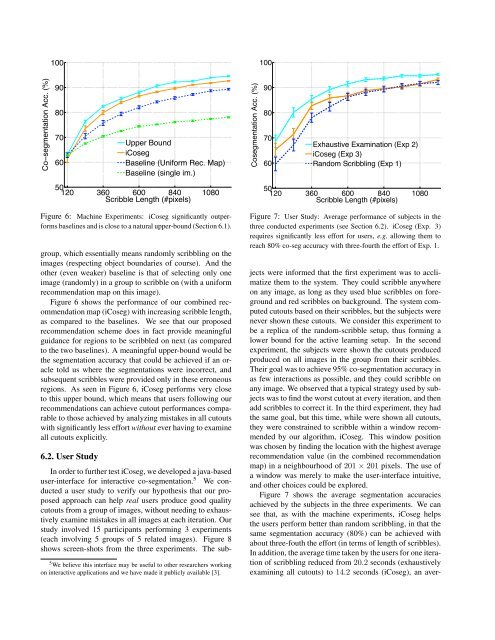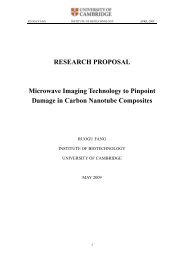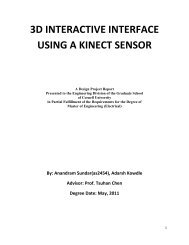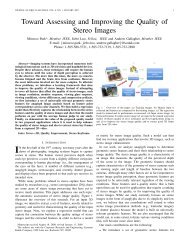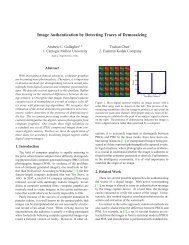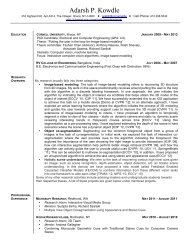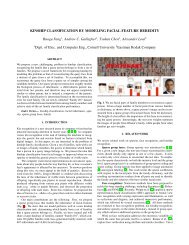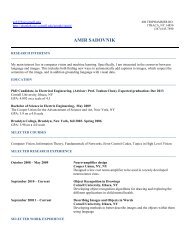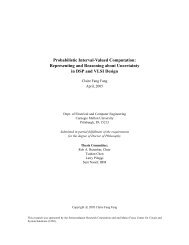iCoseg: Interactive Co-segmentation with Intelligent Scribble Guidance
iCoseg: Interactive Co-segmentation with Intelligent Scribble Guidance
iCoseg: Interactive Co-segmentation with Intelligent Scribble Guidance
Create successful ePaper yourself
Turn your PDF publications into a flip-book with our unique Google optimized e-Paper software.
<strong>Co</strong>−<strong>segmentation</strong> Acc. (%)<br />
100<br />
90<br />
80<br />
70<br />
60<br />
Upper Bound<br />
<strong>i<strong>Co</strong>seg</strong><br />
Baseline (Uniform Rec. Map)<br />
Baseline (single im.)<br />
50<br />
120 360 600 840 1080<br />
<strong>Scribble</strong> Length (#pixels)<br />
Figure 6: Machine Experiments: <strong>i<strong>Co</strong>seg</strong> significantly outperforms<br />
baselines and is close to a natural upper-bound (Section 6.1).<br />
group, which essentially means randomly scribbling on the<br />
images (respecting object boundaries of course). And the<br />
other (even weaker) baseline is that of selecting only one<br />
image (randomly) in a group to scribble on (<strong>with</strong> a uniform<br />
recommendation map on this image).<br />
Figure 6 shows the performance of our combined recommendation<br />
map (<strong>i<strong>Co</strong>seg</strong>) <strong>with</strong> increasing scribble length,<br />
as compared to the baselines. We see that our proposed<br />
recommendation scheme does in fact provide meaningful<br />
guidance for regions to be scribbled on next (as compared<br />
to the two baselines). A meaningful upper-bound would be<br />
the <strong>segmentation</strong> accuracy that could be achieved if an oracle<br />
told us where the <strong>segmentation</strong>s were incorrect, and<br />
subsequent scribbles were provided only in these erroneous<br />
regions. As seen in Figure 6, <strong>i<strong>Co</strong>seg</strong> performs very close<br />
to this upper bound, which means that users following our<br />
recommendations can achieve cutout performances comparable<br />
to those achieved by analyzing mistakes in all cutouts<br />
<strong>with</strong> significantly less effort <strong>with</strong>out ever having to examine<br />
all cutouts explicitly.<br />
6.2. User Study<br />
In order to further test <strong>i<strong>Co</strong>seg</strong>, we developed a java-based<br />
user-interface for interactive co-<strong>segmentation</strong>. 5 We conducted<br />
a user study to verify our hypothesis that our proposed<br />
approach can help real users produce good quality<br />
cutouts from a group of images, <strong>with</strong>out needing to exhaustively<br />
examine mistakes in all images at each iteration. Our<br />
study involved 15 participants performing 3 experiments<br />
(each involving 5 groups of 5 related images). Figure 8<br />
shows screen-shots from the three experiments. The sub-<br />
5 We believe this interface may be useful to other researchers working<br />
on interactive applications and we have made it publicly available [3].<br />
<strong>Co</strong><strong>segmentation</strong> Acc. (%)<br />
100<br />
90<br />
80<br />
70<br />
60<br />
Exhaustive Examination (Exp 2)<br />
<strong>i<strong>Co</strong>seg</strong> (Exp 3)<br />
Random Scribbling (Exp 1)<br />
50<br />
120 360 600 840 1080<br />
<strong>Scribble</strong> Length (#pixels)<br />
Figure 7: User Study: Average performance of subjects in the<br />
three conducted experiments (see Section 6.2). <strong>i<strong>Co</strong>seg</strong> (Exp. 3)<br />
requires significantly less effort for users, e.g. allowing them to<br />
reach 80% co-seg accuracy <strong>with</strong> three-fourth the effort of Exp. 1.<br />
jects were informed that the first experiment was to acclimatize<br />
them to the system. They could scribble anywhere<br />
on any image, as long as they used blue scribbles on foreground<br />
and red scribbles on background. The system computed<br />
cutouts based on their scribbles, but the subjects were<br />
never shown these cutouts. We consider this experiment to<br />
be a replica of the random-scribble setup, thus forming a<br />
lower bound for the active learning setup. In the second<br />
experiment, the subjects were shown the cutouts produced<br />
produced on all images in the group from their scribbles.<br />
Their goal was to achieve 95% co-<strong>segmentation</strong> accuracy in<br />
as few interactions as possible, and they could scribble on<br />
any image. We observed that a typical strategy used by subjects<br />
was to find the worst cutout at every iteration, and then<br />
add scribbles to correct it. In the third experiment, they had<br />
the same goal, but this time, while were shown all cutouts,<br />
they were constrained to scribble <strong>with</strong>in a window recommended<br />
by our algorithm, <strong>i<strong>Co</strong>seg</strong>. This window position<br />
was chosen by finding the location <strong>with</strong> the highest average<br />
recommendation value (in the combined recommendation<br />
map) in a neighbourhood of 201 × 201 pixels. The use of<br />
a window was merely to make the user-interface intuitive,<br />
and other choices could be explored.<br />
Figure 7 shows the average <strong>segmentation</strong> accuracies<br />
achieved by the subjects in the three experiments. We can<br />
see that, as <strong>with</strong> the machine experiments, <strong>i<strong>Co</strong>seg</strong> helps<br />
the users perform better than random scribbling, in that the<br />
same <strong>segmentation</strong> accuracy (80%) can be achieved <strong>with</strong><br />
about three-fouth the effort (in terms of length of scribbles).<br />
In addition, the average time taken by the users for one iteration<br />
of scribbling reduced from 20.2 seconds (exhaustively<br />
examining all cutouts) to 14.2 seconds (<strong>i<strong>Co</strong>seg</strong>), an aver-


